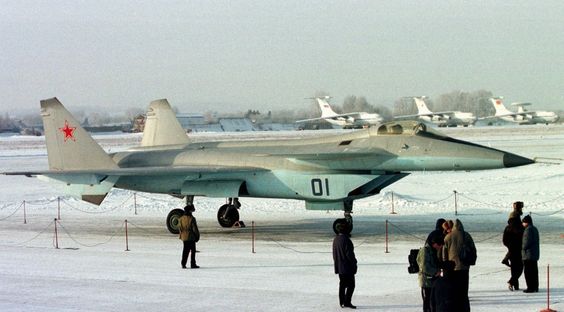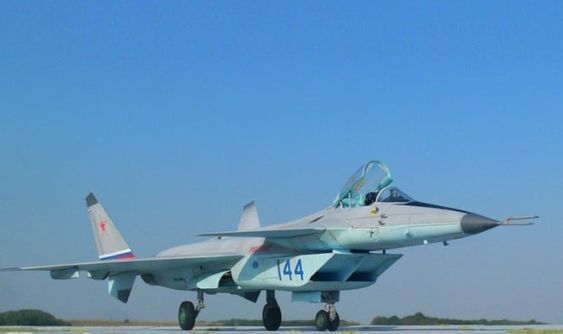This fighter nearly destroyed an F-22 Raptor-MIG/MFI 1.44
Meet Russian Response to the US F-22 Raptor
In 1980 Russian commissioned their own similar project to develop own staelth fighter Russian government gave the MFI and IFI programs the highest priority in order to counter this new threat.
MIG-1.42 prototype was built for static and ground testing which allow for a large amount of Weaponry in a full stealth configuration.
It was supposed to be the Russian Air Force’s pride to have a jet that could carry more missiles and even shoot backward, but it ended up being the ruin of the renowned Mig Bureau. The Mig MFI was the final significant project of the Soviet aviation industry before the curse of 1990s Russia and House Ahoy took control of the Russian 5th jet program.
This truly starts in the early 1980s, when Russia learned that the capitalist Americans were developing a replacement for the F-15. In order to avoid being exposed, they commissioned their own similar project to replace the Sukhoi SU-27 and sought to duplicate the success of the MIG-25 fox bat and its successor, the MIG-31 The following were the primary directives given to the different Aerospace agencies around the USSR: super flexibility
Low radar cross-section and multi-rollability supersonic Cruise Speed without afterburners constructing the new fighters.
When the Soviets learned that the Lockheed YF-22 had been chosen as the US Air Dominance Fighter for the following year by the ATF program, the government gave the MFI and IFI programs the highest priority in order to counter this new threat. The MFI was to be the new heavy multi-role fighter, and the IfI stood for light one, but Mig made the big decision to design both aircraft to utilize as many components as possible.
This victory would also confirm its terrible end. The new aircraft series MFI was given the designation I-90, which stands for fighter nighty or “Fighter for the 90s.” Various models were tested in the tsagi wind tunnels before the final design was selected. The MFI had a fairly conventional Delta win configuration, but with some interesting details that make it a pretty unique plane.
Because delta wing designs are known to be less stable without them due to the lack of horizontal stabilizers, the front of the aircraft had canards. Large variable intake ramps such as those seen on the Eurofighter would provide a constant airflow even at high angles.
Both of the first two needs were met by maneuvers and s-shaped ducts, which concealed the compressor blades. The aircraft’s two engines were Saturn al-41fs.
Because they were entirely different from the al-41s used on the SU-35 and SU-57, they should not be confused with those engines. MFI’s engines also included thrust-vectoring nozzles along with ceramic plates on the interior of the nozzles to minimize the IR signature even though the flying prototype didn’t have a weapons system. The only reason they weren’t employed on the SU-57 is that they were just too huge a bay.
If they only use the internal Bay, the 1.42 prototype one built for static and ground testing would allow for a large amount of Weaponry in a full stealth configuration, but when they decided to use the external hardpoints as well, they would be able to carry large air-to-ground missiles like the ha 29 31, 55, and others making it a truly multi-role fighter ticking the last requirement. Another innovative feature of the Ks (43) aircraft was its capacity to fire missiles in the direction of the opposing planes in a dogfight if the pilot’s safety was in danger.
In conclusion, all design decisions were made in accordance with a set of requirements and promised a very serious competitor to the Raptor in the future, but alas in our story very soon everything went wrong to say that the 1990s changed everything would be an understatement with large canards in the front having also a dog tooth or a small extension which would help install resistance and with maneuverability
But with this program, it was a completely different story. The MFI and IfI programs, as well as the T10V, which would ultimately become the Su-34, were top priorities and would still receive funding from the new government by 1994. The partially finished Prototype was then moved to Jokowsky Airport to conduct ground testing and high-speed ground tests.

In order to get back on track, Mig decided to scrap their Ifi development plans in order to try and convince the military and government officials to let them show the aircraft to the world in the hopes that with its performance at an international air show, potential foreign investment would resume. However, due to a lack of progress and their government breathing down their necks, the program would come to an end because there was simply not enough money the engineers didn’t even have enough to buy wiring to complete the prototype.
They would actually be their rival Sukhoi who would come to the rescue in a roundabout way; they had their own jet fighter canceled many years ago but chose to stick it to the new government and build it anyhow. Sukhoi would surprise everyone with their SU-47 reveal in 1997; a jet that they finance themselves and built despite the government shutdown so now Mig was motivated to continue at all because this wasn’t enough the bureau even begged the actual management of the Mig Bureau the development continued well sort of by the year 2000.

there Dahlia 144 or better known as the mig-144 finally took to the skies with the hero of Russia tasp Island Vladimir Gorbunov behind theControls in his words the aircraft performed very well in their second long flight soon followed so there was still hope for this program uh except that there wasn’t for you see the whole thing was too late.
there are a couple of reasons behind the complete failure of the mfi program and the mig-144 as the aircraft the first was very simple their first flight occurred 10 years after its counterpart by the time Raptors were in operational service the Mig was just testing basic flight performance they were looking at another 10 or so years to put this aircraft into operational service and by then it’d be completely obsolete the second reason was the obvious one money but not just the lack of funding but also the unit cost Meg projected that the unit cost for this jet would be around 70 million US dollars compared to around 71 million for the F-22 at the time this was a completely unacceptable embarrassment for the fragile Russian economy it led to an easy choice to cancel the project after all nobody can buy it if they can’t afford it their third and final fact was that the Mig Bureau was going through a very rough phase many corruption scandals slow International sales and not enough work from the Russian Air Force and even the legendary test pilot left the company and he was to be the lead pilot for the program it seemed like Mig sacrificed everything to build this 144 and it was an empty shell by the end of it in the end a new program was opened called the pakfa and their Sukhoi was chosen without any competition as a bureau to work on the project because of its Financial stability great sales performance and successful development of the flanker family everything the Mig Bureau wasn’t also the su-47 was developed completely on their own budget and without government funds and was far more successful than the m-rateu Mig-144 this was also the moment which marked the start of the endeavorable end for the legendary McQueen and gullyroovich Bureau which merged with a few other Russian bureaus into the UAC or United aircraft Corporation in 2006.
New programs like the MIG-41 which you can check out here on the channel leave some light at the end of the tunnel for the company but Joseph was seen recently the final end to the Imfs project and the birth of yet another Sukhoi the SU-75 Checkmate this is doubtful for a long the only flying prototype of the MIG-144 was rotting on the tarmac of the Makovsky airport but it was refurbished and displayed at the max air show in 2015 with a hope for a future in the museum because it is undoubtedly a big part of the rich Soviet and Russian aviation history









